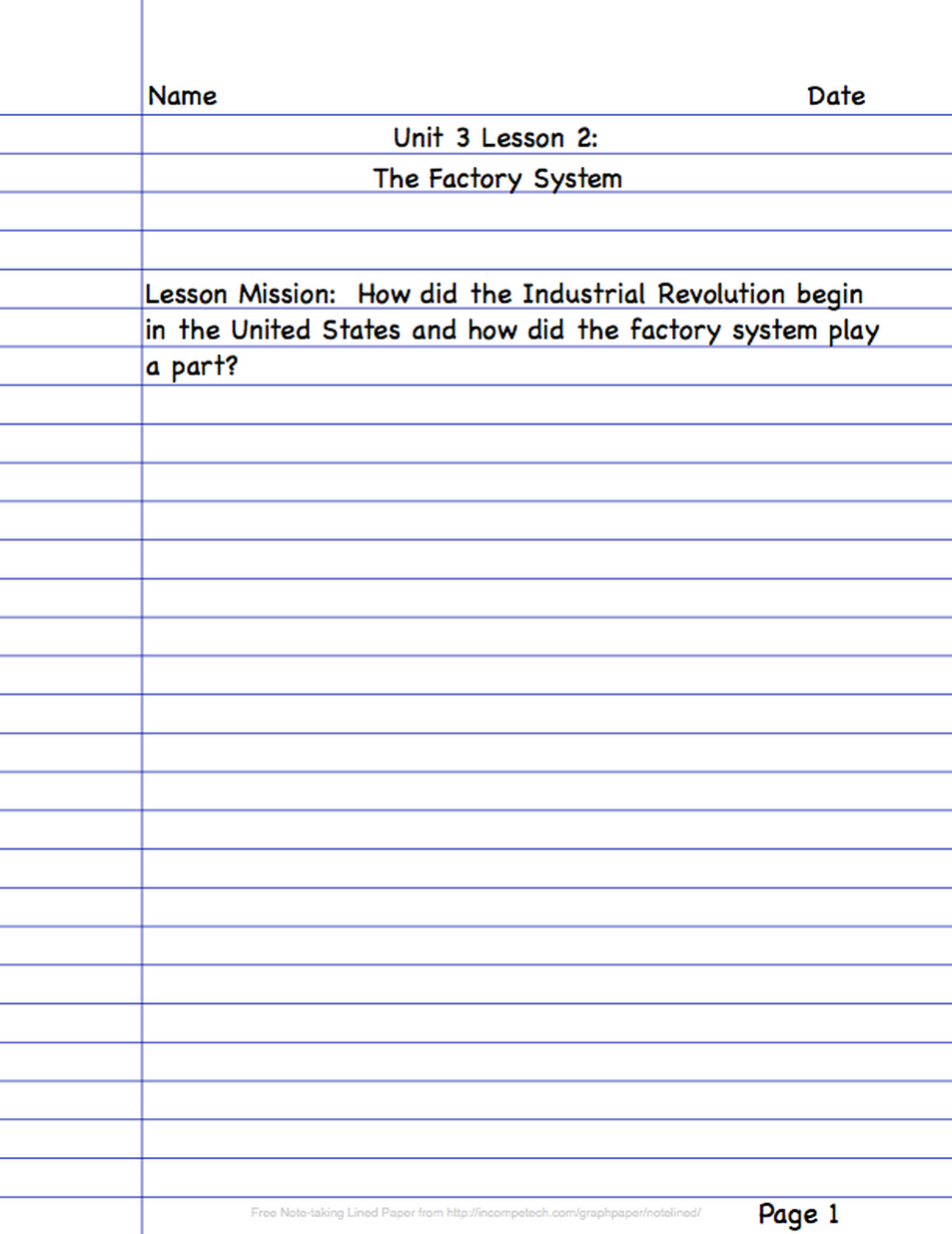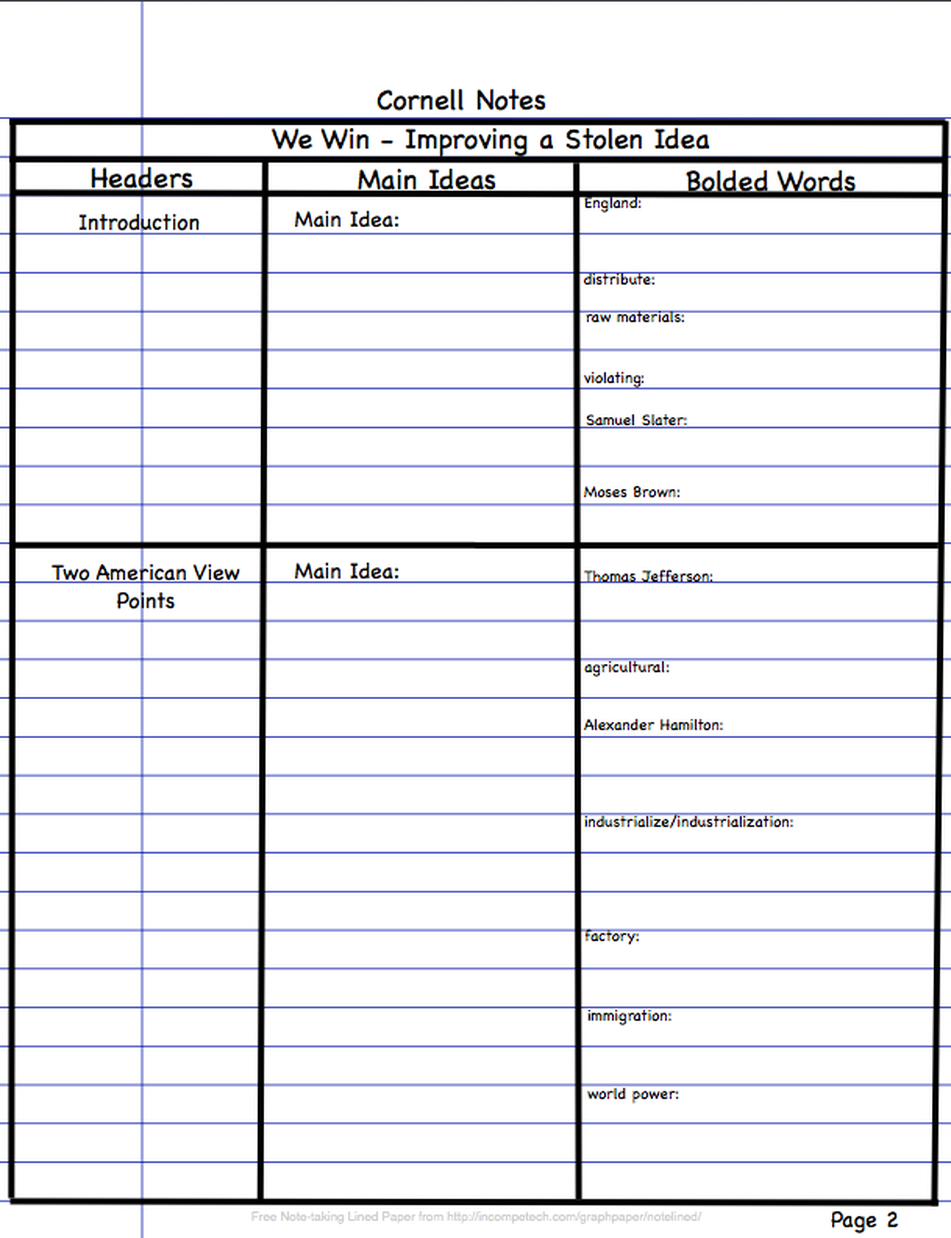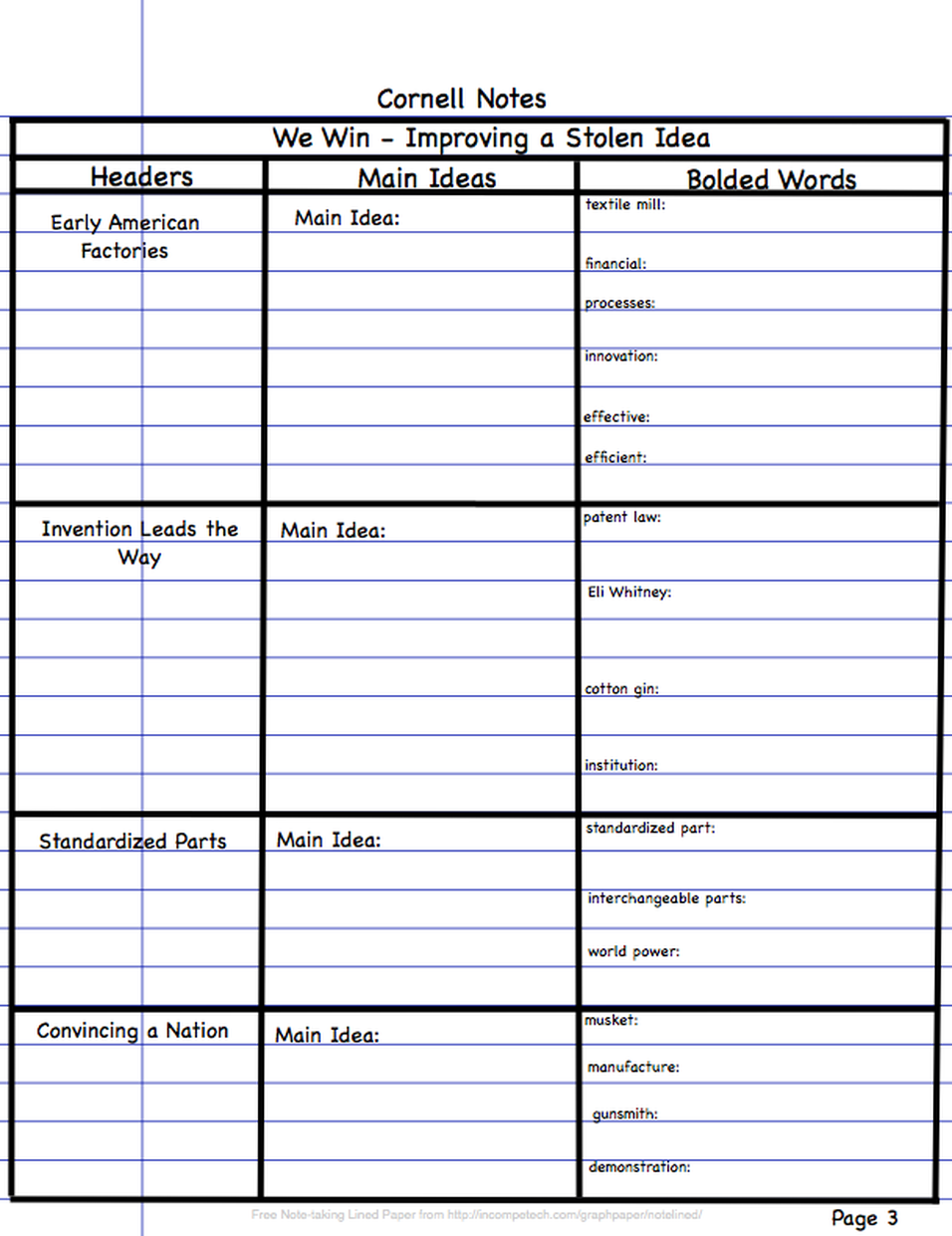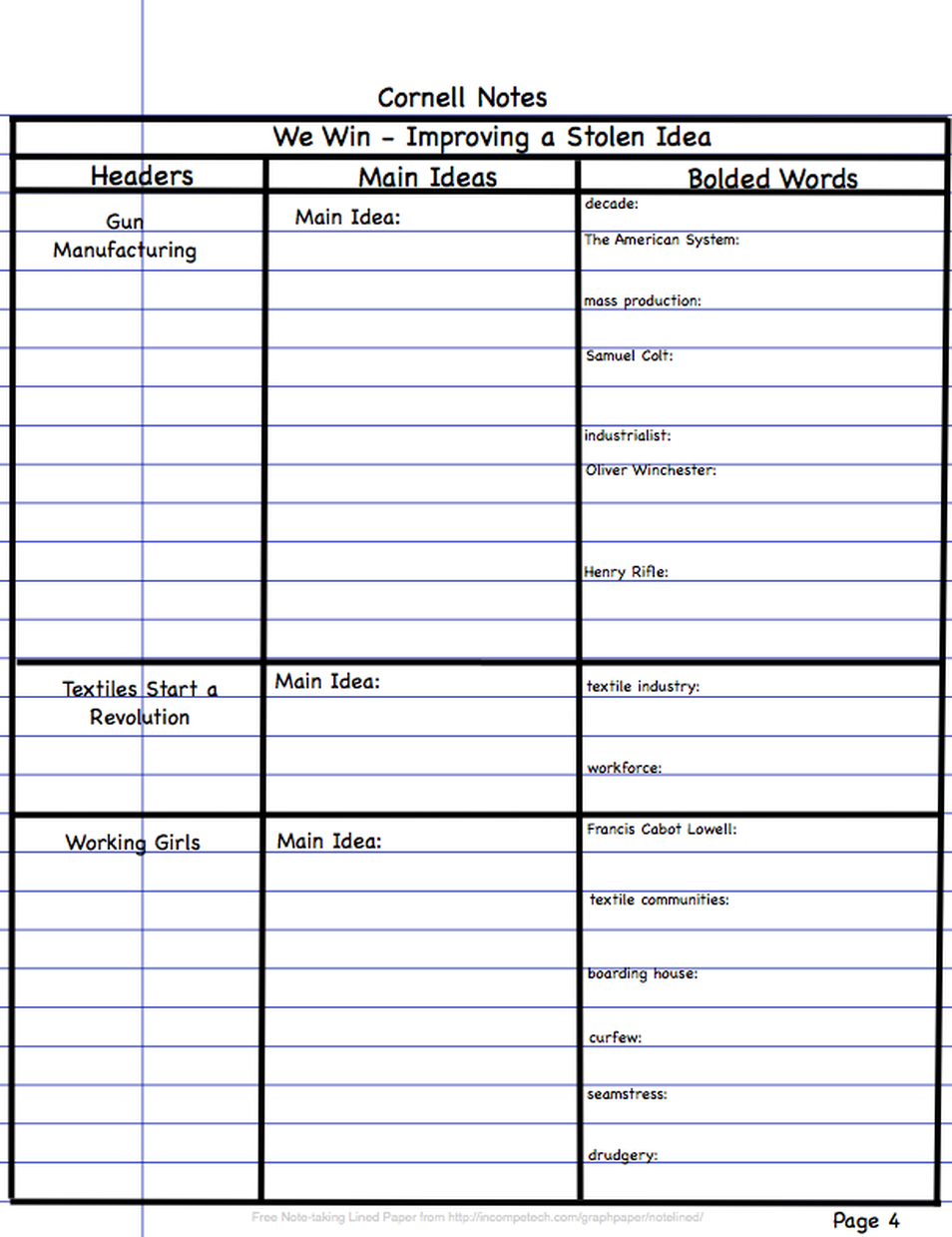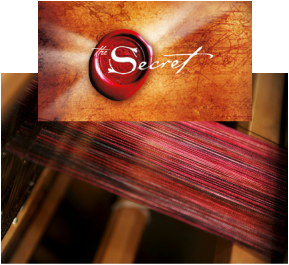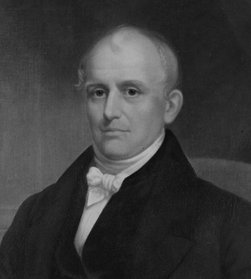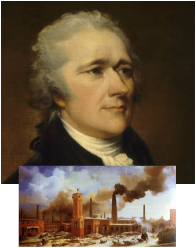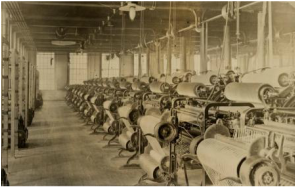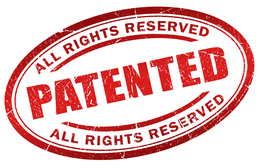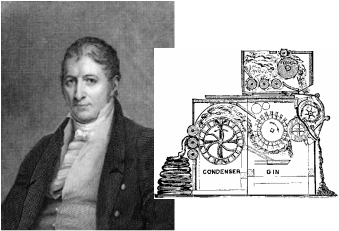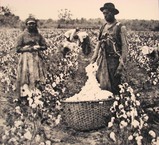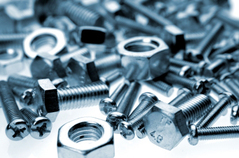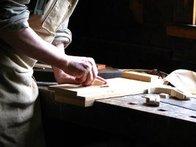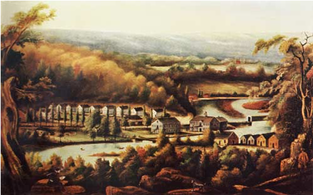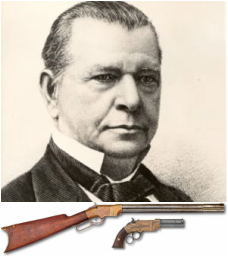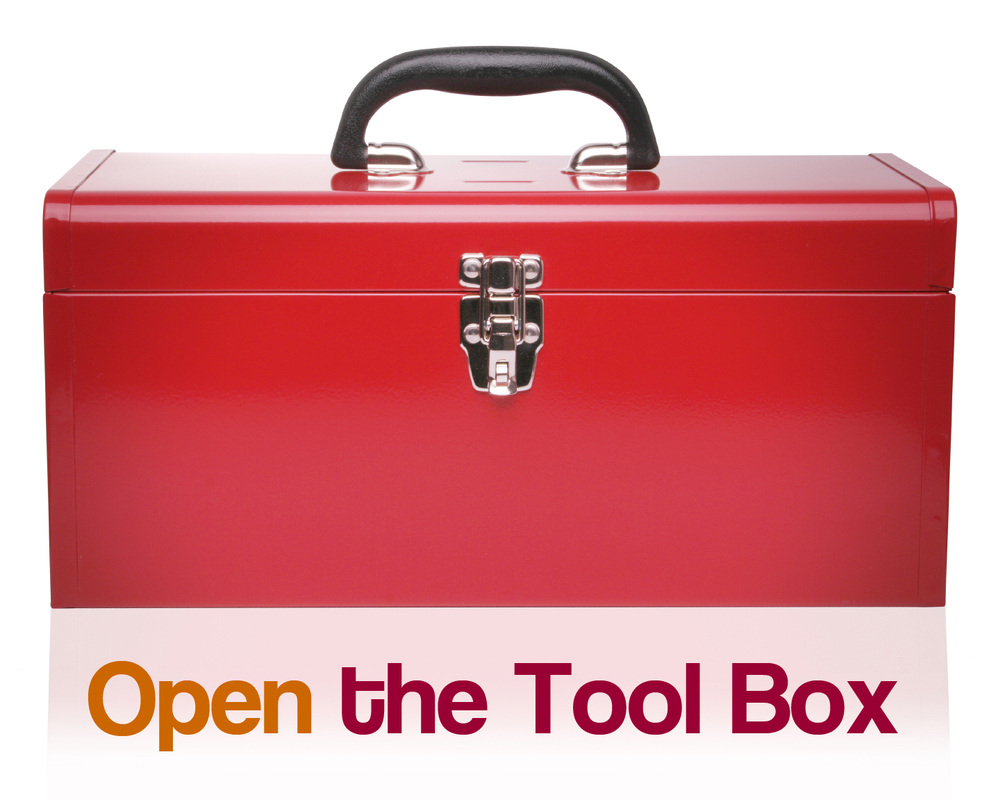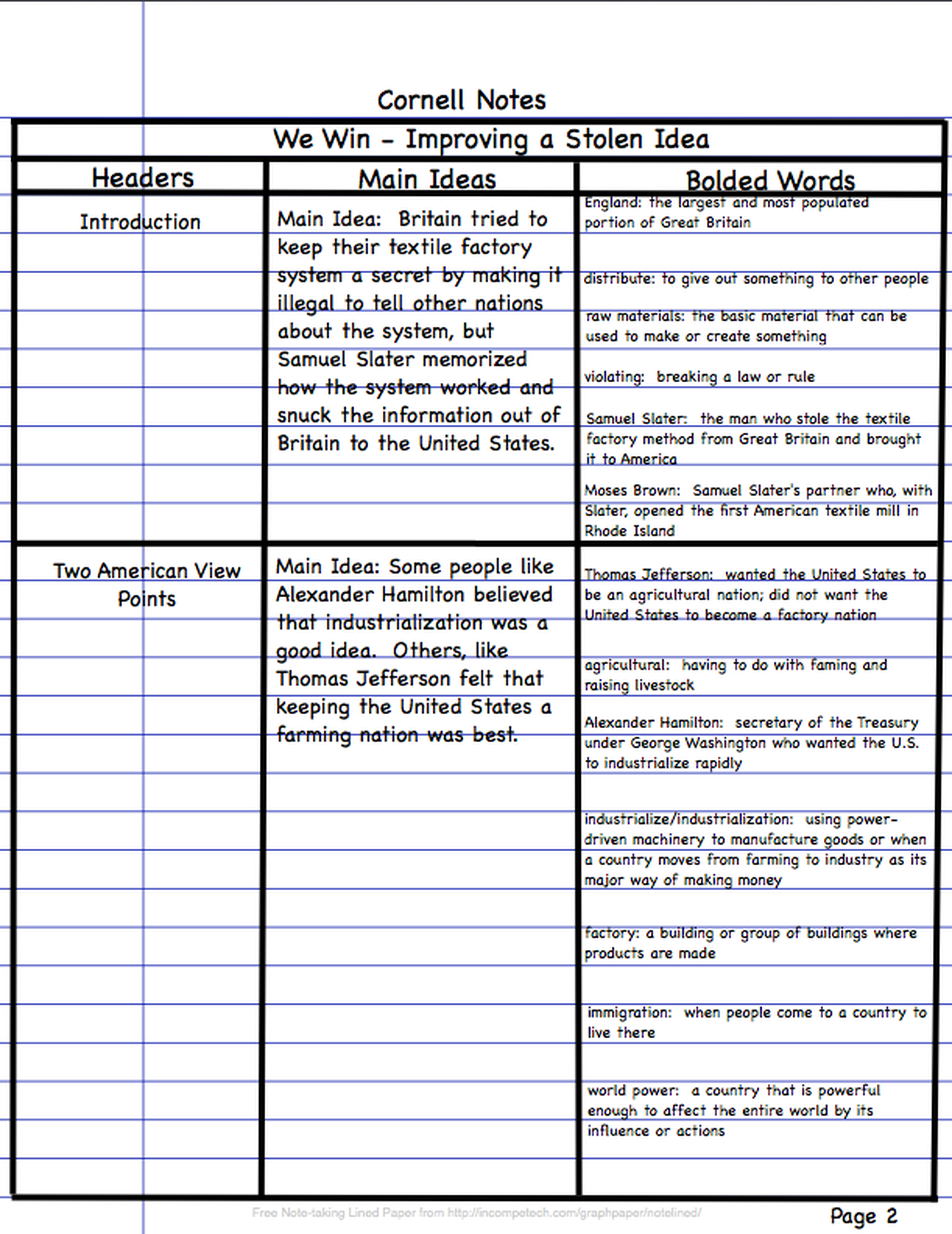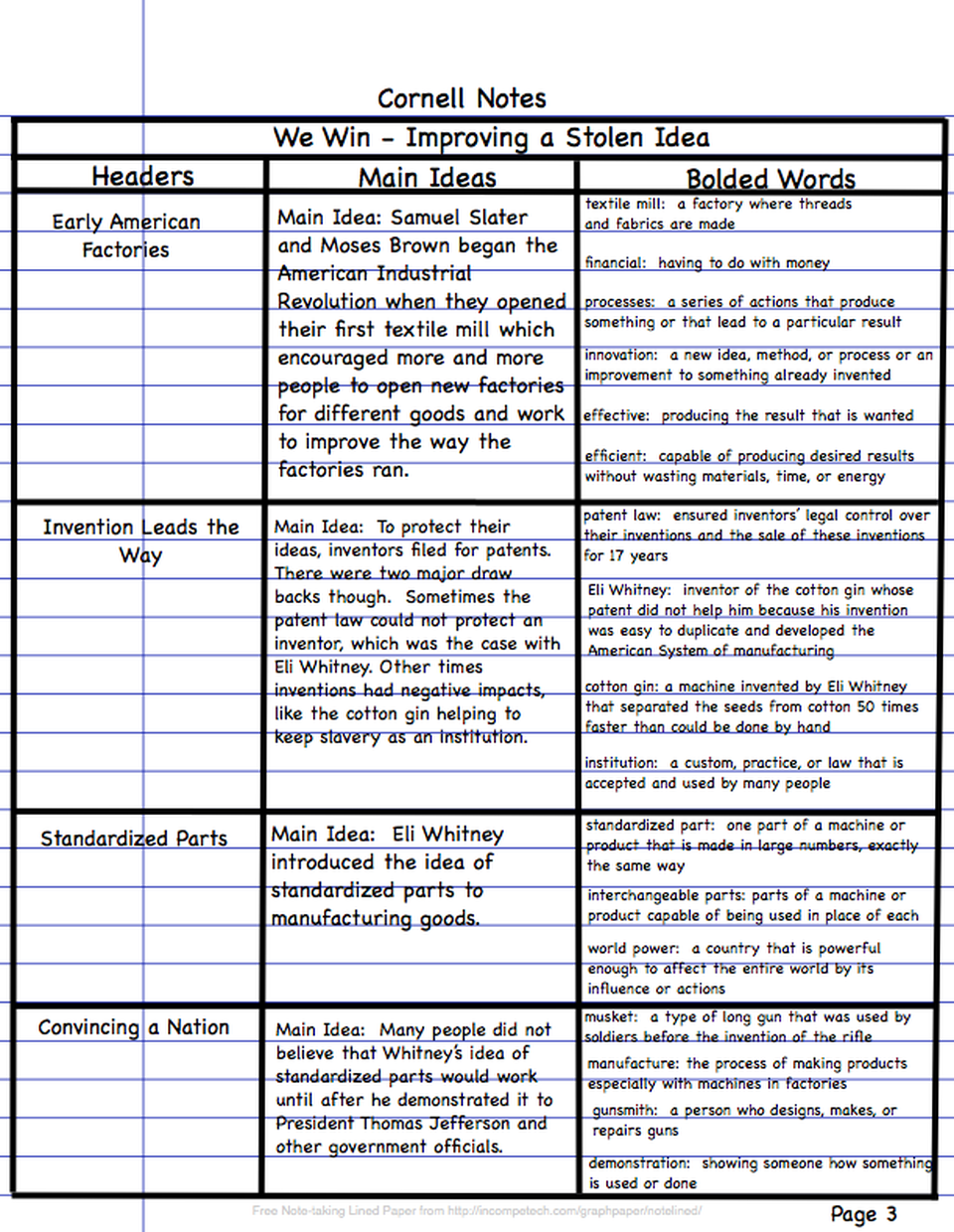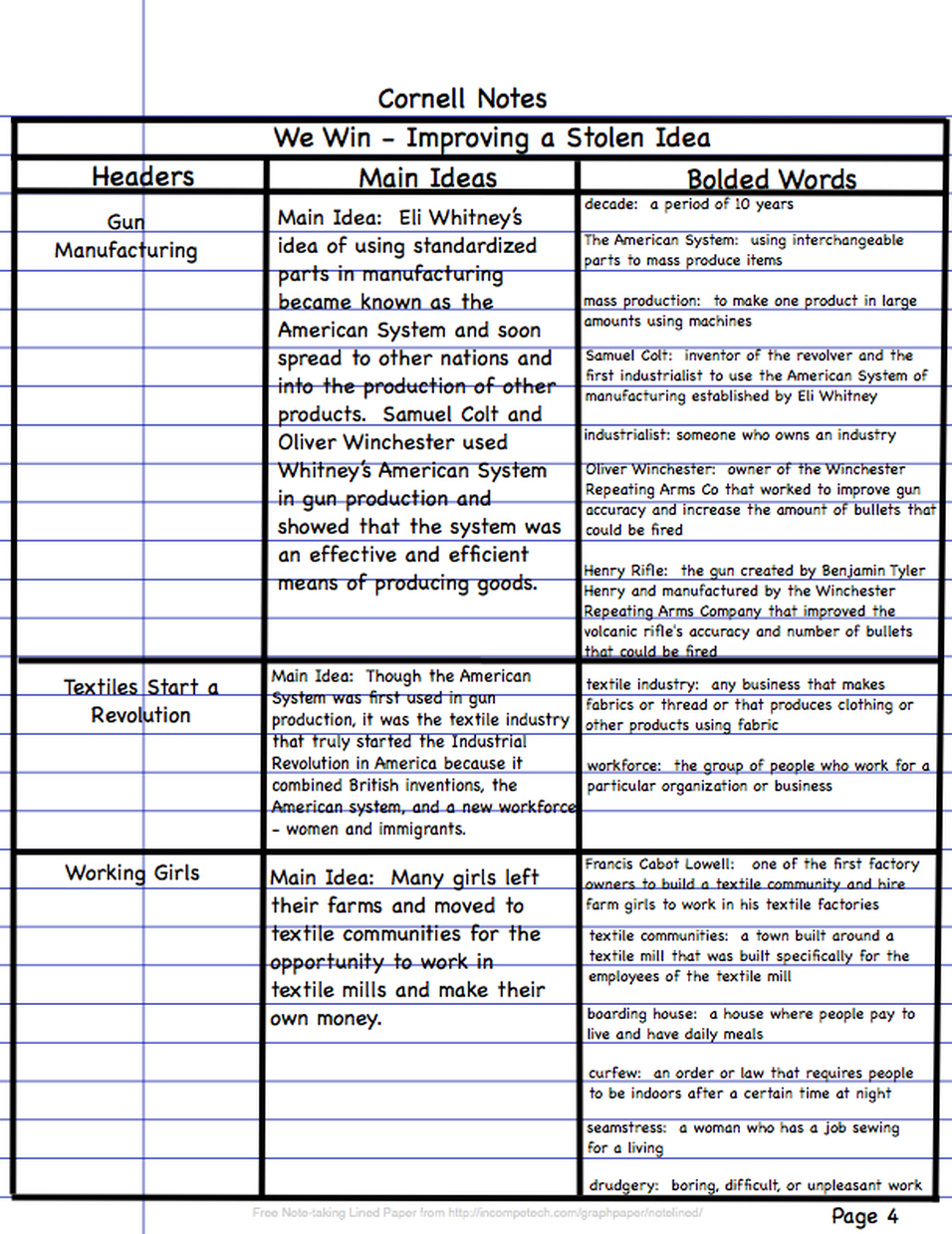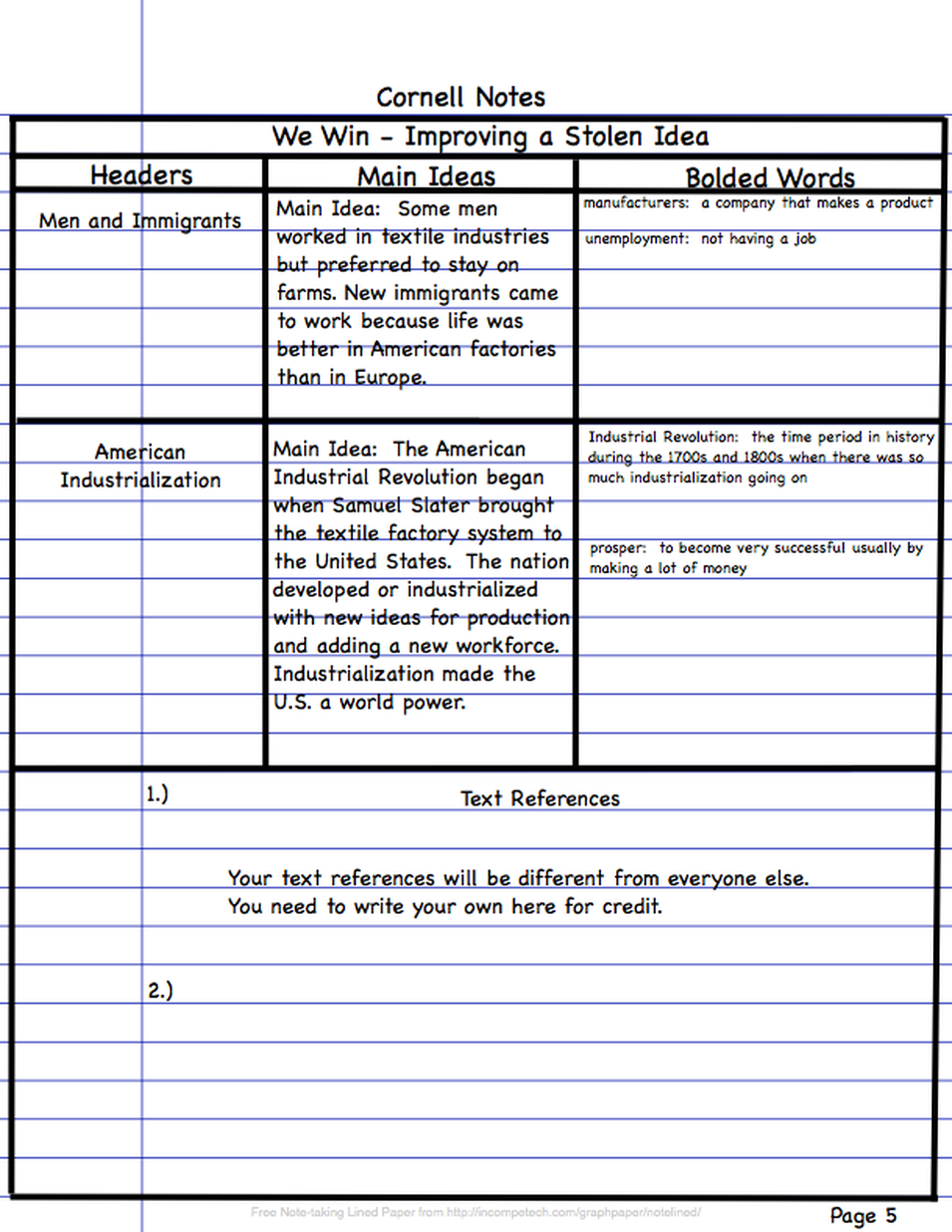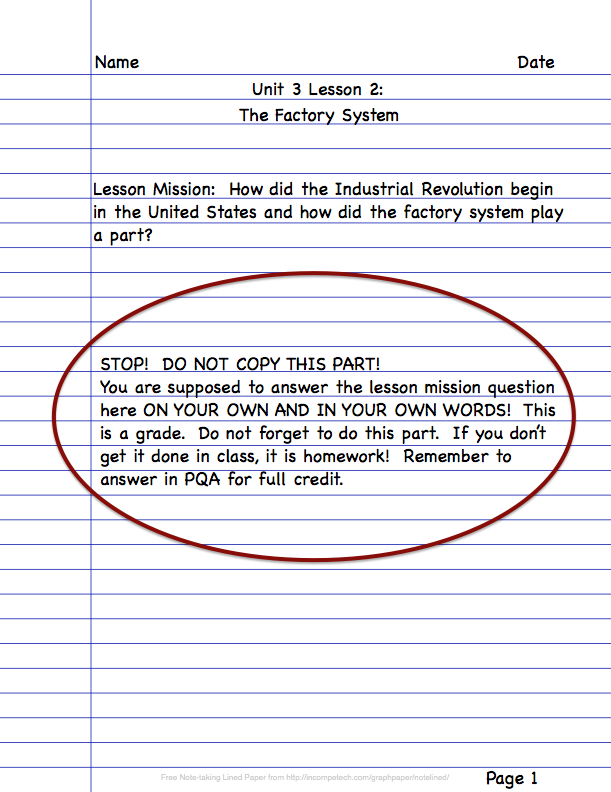Unit 3: The Industrialization Age
Topic 1: Industrialization
Topic 1: Industrialization
LESSON 2
THE FACTORY SYSTEM
FOCUS ACTIVITY
Lesson Mission

DIRECTIONS: Remember, the Lesson Mission is what you, the student, will be able to do after the lesson is over. Begin today's Lesson Chronicles Entry by heading your paper with your name and the date and the Lesson Title. Write down today's essential question. Answering the essential question at the end of the lesson is your Lesson Mission!
Essential Question(s):
How did the Industrial Revolution begin in the United States and how did the factory system play a part?
How did the Industrial Revolution begin in the United States and how did the factory system play a part?
Set up your Lesson Chronicles for today like the example below.
TEACHER ACTIVITY
Pre - Reading - Making a Skeleton Outline

DIRECTIONS: Remember, accomplishing your lesson mission is your purpose for reading. To accomplish your mission, you must be able to answer the essential question(s). We will continue to work on answering essential questions by identifying information from key text structures to make a skeleton outline of the text.
|
Recall the Key Text Structures in Non-Fiction Text:
1. Headers 2. Sub-headers 3. Bolded Words 4. Italicized Words 5. Pictures & Captions 6. Boxed off Information 7. Charts and Graphs 8. Maps |
Create a Skeleton Outline:
1. Column 1: Headers and Sub-headers 2. Column 2: Main Idea 3. Column 3: Bolded words with definitions and descriptions 4. Bottom Row: Text References - These are your own personal thoughts about the reading! |
Set up the Skeleton Outline for today like the example below.
WHOLE GROUP ACTIVITY
Guided Reading

DIRECTIONS: Now that you have a purpose for reading, and you have identified the key elements of the reading, we will take turns reading the passage below as a class.
As you read, if a certain part of the reading makes you think of a text to text, text to self, or text to world connection, write it in the bottom row.
Recall the text to text, text to self, and text to world strategy:
As you read, if a certain part of the reading makes you think of a text to text, text to self, or text to world connection, write it in the bottom row.
Recall the text to text, text to self, and text to world strategy:
- Text to text references: When a certain word, phrase, or sentence reminds you of something else that you have read.
- Text to self references: When a certain word, phrase, or sentence reminds you of something about your own life.
- Text to world references: When a certain word, phrase, or sentence reminds you of a world issue or event.
~ WE WIN ~
IMPROVING A STOLEN IDEA
TEXTILES START A REVOLUTION
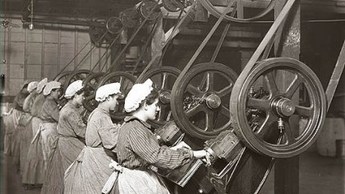 Young women were a new addition to the workforce.
Young women were a new addition to the workforce.
After Eli Whitney developed the American System, factories of all kinds developed quickly. As you can see, gun manufacturing did not really take off until the mid to late 1800s. It was the textile industry that led the United States into industrialization. Textiles had started the British Industrial Revolution. Samuel Slater took all that he learned about textile production in Britain and created textile mills in the United States. Eli Whitney created the American System when he introduced interchangeable parts to the textile industry. The textile industry led the United States into the Industrial Revolution because the U.S. combined the new inventions and factory method of production created by the British with the new American System of using interchangeable parts in manufacturing. There was another factor that greatly contributed to the success of the textile industry. This was the new workforce of women and immigrants.
WORKING GIRLS
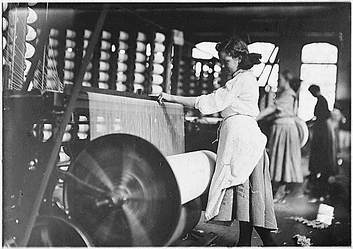 Many girls chose to work in textile factories over working on the family farm.
Many girls chose to work in textile factories over working on the family farm.
Textile factory owners in Massachusetts found that they could hire farm girls to work in their factories for about $3 a week, depending upon their experience and effort. Francis Cabot Lowell was one of the first factory owners to try hiring farm girls to work in his textile factories. His mill agents promised the farm girls' parents that the girls would be well cared for and protected. The girls moved to textile communities where they lived in company-owned boarding houses. The girls earned cash wages and mill owners offered a variety of social events for the girls to attend for fun. The girls agreed to a strict set of rules including church attendance and curfews. In the 1800’s, job options were limited for women and the Textile Mills offered them the opportunity to earn their own money. Although the wages were low, it was more than the girls could make as seamstresses or servants, who made less than a dollar a week at home. Many young women preferred the excitement of living on their own to the drudgery of the farm. As a result, thousands of single girls worked in the mills for a few years until they married.
MEN AND IMMIGRANTS
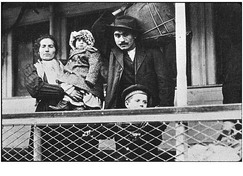 With hope for a brighter future, nearly 12 million immigrants arrived in the United States between 1870 and 1900.
With hope for a brighter future, nearly 12 million immigrants arrived in the United States between 1870 and 1900.
Men who worked in the factories were paid twice as much as the girls but were often hard for manufacturers to keep. Most young American men preferred to take a chance on farming with the hope of owning land and becoming independent. Businessmen encouraged immigration because many of the people arriving from other countries were grateful for the chance to get any kind of job. Life was better for American factory workers than it was for the struggling and often unemployed people in Europe.
AMERICAN INDUSTRIALIZATION
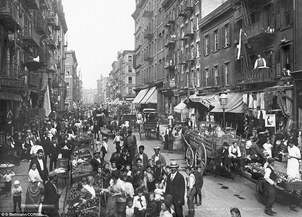 Industrialization caused many cities to get larger with the arrival of new migrants and immigrants.
Industrialization caused many cities to get larger with the arrival of new migrants and immigrants.
When Samuel Slater stole the factory system idea and brought it to America, he started the American Industrial Revolution and a chain of events that led to U.S. industrialization. He inspired people like Alexander Hamilton to believe that our nation would prosper as an industrialized society. Believers in industry set out to prove that industrialization was the path America should take. Eli Whitney introduced the "American System" in which he added interchangeable parts to manufacturing. Francis Lowell Cabot added women to the workforce for the first time in America and constructed communities for them to live in. Immigrants moved to America for the chance to make more money working in factories. As more people began working in factories, America's industries grew larger and more and more people moved away from their farms for the opportunities that factory work provided. The U.S. grew and prospered because of industrialization. U.S. Industrialization led the United States to eventually become a major world power!
SMALL GROUP ACTIVITY
You Choose Adventure!

In this activity, your group will participate in a you choose adventure where you are a farm girl named Eliza Paige. You go to Lowell Mill to work in the textile factory there. The choices you make were made by real girls of this time. The choices you make will determine Eliza's outcome. When your group has completed the you choose adventure, raise your hand. I will come to you to see your outcome. You may also play this you choose adventure at home as much as you like.
To get started, click on the Lowell Mill Girl, You Choose Adventure picture icon above.
To get started, click on the Lowell Mill Girl, You Choose Adventure picture icon above.
INDIVIDUAL ACTIVITY
Answering the Essential Question

A Lesson Chronicles Activity is an individual activity where you prove that you accomplished the lesson mission. Lesson Chronicles require you to keep a notebook or journal with a table of contents. Each entry should be dated. First, you write the lesson mission. Then you prove you "can do" whatever the mission says by answering the essential question of the lesson in PQA format. Remember PQA format means "Put the Question in the Answer".
DIRECTIONS: Work by yourself to prove you have completed today's mission successfully by answering the essential question for today. Answer the question on the first page of your Lesson Chronicles under your Lesson Mission. Refer to the example below. The example shows you what all you are expected to have for your portfolio check on this lesson.
HOMEWORK
Finish the Lesson and Family Time

Remember, you have homework every night in Social Studies. Your homework is to show your Lesson Chronicles to your family and tell them what you learned today. Not only will this give you quality time with your family but it will help you review for your unit test. Go over your lesson chronicles entry from today everyday to help you study for the Topic Quiz and Unit Test.
If you did not complete any assignments from today, they are homework. You never know when I am going to check portfolios, so make sure you are keeping up!
If you did not complete any assignments from today, they are homework. You never know when I am going to check portfolios, so make sure you are keeping up!
END OF THE UNIT 3 LESSON 2 MODULE
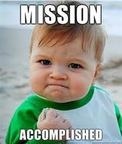
Congratulations! You have Completed the Unit 3 Lesson 2 Module!
If you'd like to learn more about the the Lowell Mill Girls and how the factory system developed, watch the videos below. You must use your headphones. You may watch this at home as well!
If you'd like to learn more about the the Lowell Mill Girls and how the factory system developed, watch the videos below. You must use your headphones. You may watch this at home as well!
|
Mill Times by Slimaksclass at Youtube
This movie is an animation (cartoon) of how mills were started and developed in the United States. |
The Lowell Mill Girls by Lauren Meyering
This movie was made by high school students and produced by Lauren Meyering called The Lowell Mill Girls. It tells how the Lowell Mill Girls were the first women to attempt to get equal treatment for women and try to expose the poor working conditions that developed at the mill. Parts of the movie are hard to hear and you'll need to adjust your headphones. |
